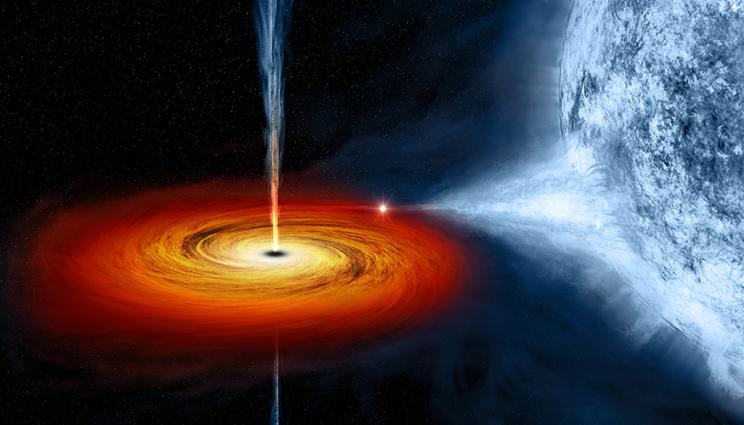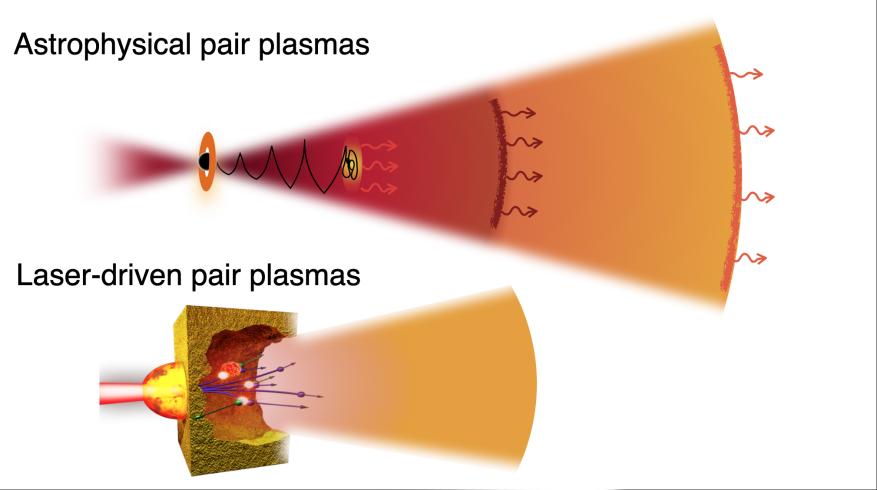
An LLNL researcher and collaborator have reviewed how lasers can create energetic electron-positron pairs that are common in extreme astrophysical environments associated with the rapid collapse of stars and formation of black holes. Image courtesy of NASA/CXC/M.Weiss.
High-power lasers now create record-high numbers of electron-positron pairs, opening exciting opportunities to study extreme astrophysical processes, such as black holes and gamma-ray bursts.
Positrons, or "anti-electrons," are anti-particles with the same mass as an electron but with opposite charge. The generation of energetic electron-positron pairs is common in extreme astrophysical environments associated with the rapid collapse of stars and formation of black holes. These pairs eventually radiate their energy, producing extremely bright bursts of gamma rays. Gamma-ray bursts (GRBs) are the brightest electromagnetic events known to occur in the universe and can last from ten milliseconds to several minutes. The mechanism of how these GRBs are produced is still a mystery.
That's where high-power lasers come in. In the laboratory, jets of electron-positron pairs can be generated by shining intense laser light into a gold foil. The interaction produces high-energy radiation that traverses the material and creates electron-positron pairs as it interacts with the nuclei of the gold atoms along its path.
A new review of the current breakthroughs in the creation of electron-positron pair plasma, its main challenges and the future of the field, authored by Lawrence Livermore National Laboratory (LLNL) physicist Hui Chen and SLAC National Accelerator Laboratory scientist Frederico Fiuza, appears in Physics of Plasmas.
“The ability to produce relativistic pair plasmas in the laboratory provides a unique opportunity to advance our understanding of these exotic plasma regimes and to benchmark current theoretical models and numerical simulations of the roles these plasma processes play in astrophysical environments,” Chen said.
Electron-positron pair plasmas are abundant in high-energy astrophysical systems, such as those associated with neutron star and black hole environments. The interactions of photons with each other and with strong magnetic fields lead to prolific pair creation via electromagnetic cascades. These pair plasmas are typically hot and can be accelerated to high speeds in the winds or jets associated with these compact astrophysical objects, including pulsar magnetospheres, jets from active galactic nuclei and GRBs.

In the upper image, relativistic electron-positron (pair) plasmas abound in the environments of astrophysical compact objects (e.g., black holes and neutron stars) and are important to understand their high-energy emission. Lower image, In the laboratory, high-power lasers are enabling the production of dense relativistic pair plasmas that can be used to study the basic processes behind these extreme astrophysical systems in the near future. Image by Federico Fiuza/SLAC National Accelerator Laboratory.
“Despite significant advances in theoretical and numerical studies of relativistic pair plasmas, our understanding of the plasma dynamics at these exotic, but rather important, regimes is still limited,” Fiuza said. “The fundamental interest and astrophysical importance of relativistic pair plasmas has motivated efforts to produce and study them in the laboratory.”
Using ever more energetic lasers, Lawrence Livermore researchers in 2015 produced a record high number of electron-positron pairs, breaking a prior record from previous experiments at LLNL's Titan laser in 2008, when Chen's team had created billions of positrons.
Chen and Fiuza said that while the full range of conditions associated with compact astrophysical objects is unattainable in terrestrial laboratories, there is significant value in the development of experimental platforms that would enable studies of the basic collective processes associated with pair plasmas in a controlled environment.
In the past decade, extraordinary discoveries associated with extreme astrophysical plasmas have excited scientists and the public alike — from the first images of the plasma orbiting a black hole to the high-energy cosmic rays and radiation produced by relativistic jets and gamma-ray bursts to fast radio bursts from galactic neutron stars. It has long been long been known that the plasmas at the cores of these extreme environments are relativistic and often electron-positron-pair-dominated.
In the review, Chen and Fiuza presented their perspectives for future experimental studies in this frontier topic. They discussed the possibility of producing relativistic pair plasmas and the study of their collective modes over a wide range of conditions. They also addressed the prospects for studying streaming instabilities associated with the propagation of relativistic pair beams on ambient electron-proton plasmas.
“This is a fast-developing field, motivated by exciting observational discoveries, theoretical and computational developments and technological advances in light sources and diagnostics that are pushing the limits of our understanding of relativistic pair plasmas,” Chen said.
Chen and Fiuza hope that their work can constitute a useful resource, providing an additional stimulus to young scientists entering the field and to the community in general for the developments ahead.
The LLNL portion of the work was provided by the Laboratory Directed Research and Development program.
News from: https://www.llnl.gov/news/illuminating-science-black-holes-gamma-ray-bursts-using-high-power-lasers


